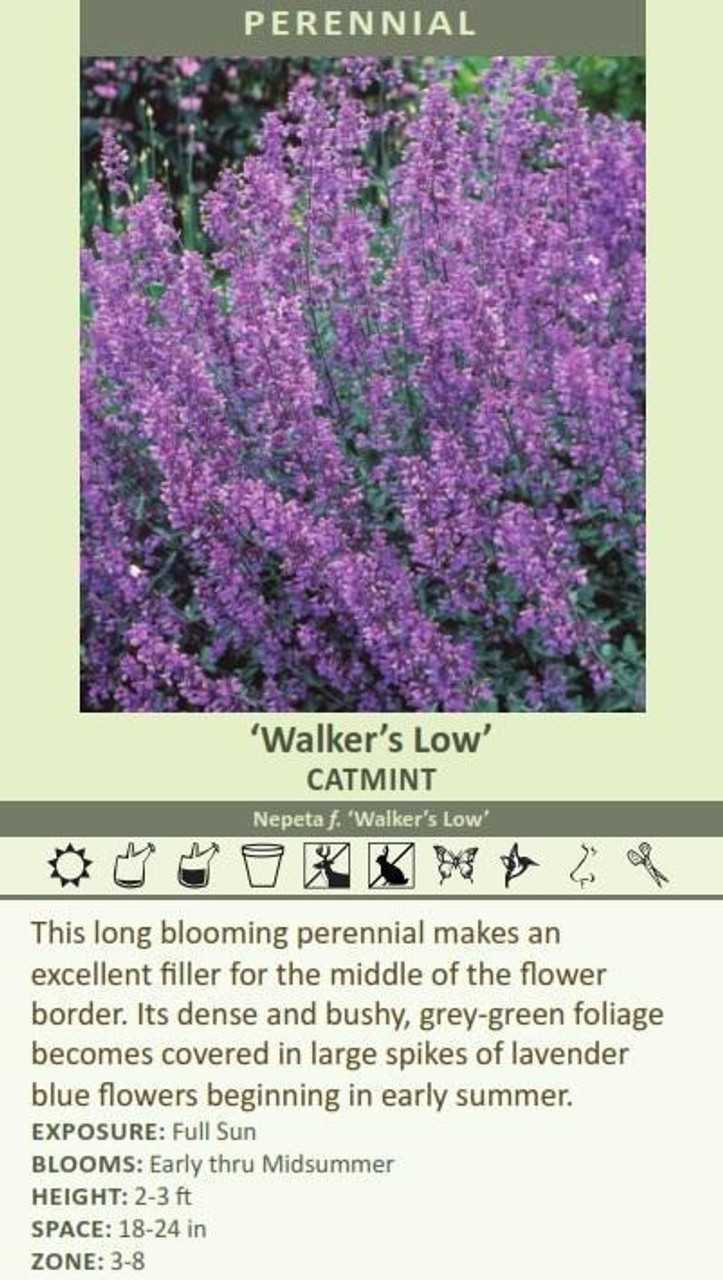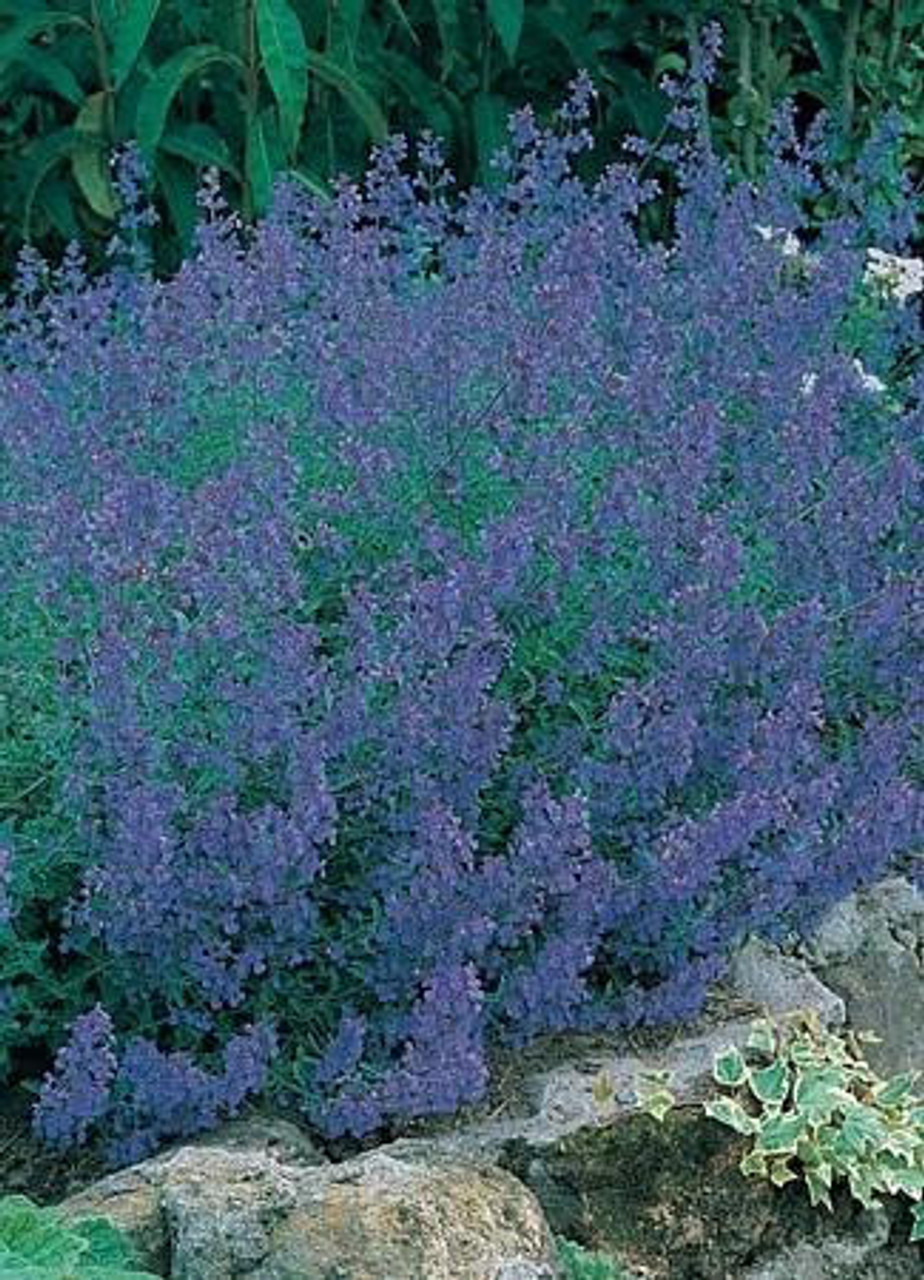Product Description
Nepeta faassenii 'Walker's Low' (4) 1-gallons
a/k/a Catmint and Catnip
The cultivar name is somewhat misleading, the plant is named for its garden of origin, not its growth habit.
Gray-green, aromatic foliage gives way to a plethora of soft lavender-blue flowers which are produced over a long period in summer. Although the stems are 2-3' long, the plant's arching habit brings the height down to 18-24" if it is not staked. When Nepeta's stems are broken, they release an aroma into the air that tends to attract cats, thus its common name, Catmint.
Perennial Plant Association Plant of the Year -- 2007
Royal Horticultural Society's Award of Garden Merit -- 2012
Missouri Botanical Garden Plants of Merit
Height: 24.0-36.0 Inches
Spread: 18.0-24.0 Inches
Hardiness Zones: 3,4,5,6,7,8
Flower Color: Purple-blue shades
Foliage Color: Green shades
Full Sun (> 6 hrs. Direct Sun)
Low to Average Water Needs
Poor to Average Soil Quality
Bloomtime: Early Summer - Midsummer
Attracts Butterflies and Hummingbirds
Bee Friendly
Deer and Rabbit Resistant
Growth Rate: Medium
Nepeta faassenii 'Walker's Low' is a popular perennial plant known for its beautiful lavender-blue flowers, attractive gray-green foliage, and long blooming season. It is a favorite among gardeners for its hardiness, low maintenance, and ability to attract pollinators.
- Abundant blooms: Produces masses of lavender-blue flowers from late spring to early fall.
- Compact habit: Grows in a mounded form, typically reaching 1.5 to 2 feet tall and wide.
- Aromatic foliage: The gray-green leaves release a pleasant, minty fragrance when brushed or crushed.
- Pollinator magnet: Attracts bees, butterflies, and other beneficial insects.
- Deer and rabbit resistant: The aromatic foliage deters these common garden pests.
- Drought tolerant: Once established, it can withstand dry conditions.
- Low maintenance: Requires minimal care, making it a great choice for busy gardeners.
Uses in the Garden:
- Borders and edging: Its compact habit makes it ideal for defining garden beds and walkways.
- Rock gardens: Thrives in well-drained soil and adds a touch of color to rocky landscapes.
- Cottage gardens: Its informal, billowing form blends well with other cottage garden favorites.
- Container gardens: Can be grown in pots to add color and fragrance to patios and balconies.
- Mass plantings: Creates a stunning display when planted in large drifts.
Tips for Growing:
- Sunlight: Plant in full sun for optimal flowering.
- Soil: Prefers well-drained soil.
- Watering: Water regularly until established, then only during prolonged dry periods.
- Pruning: Deadhead spent flowers to encourage continuous blooming. Shear back by about one-third after the first flush of blooms to promote a second flush.
- Dividing: Divide plants every few years to maintain vigor.
Nepeta faassenii 'Walker's Low' is a versatile and reliable plant that adds beauty, fragrance, and life to any garden.
Its long blooming season, attractive foliage, and ability to attract pollinators make it a top choice for gardeners of all levels.
Border Plant, Cut Flower, Cut Foliage, Drought Tolerant, Easy To Grow, Fragrant Flowers, Fragrant Foliage, Mass Planting
(4) 1-gallon containers ready to plant, plants may be trimmed for shipping,
Other Details
The most important part of the plant is its root system. Healthy roots are the foundation of a healthy, vibrant plant. The type of plug container used is based on the specific needs of the plants. Perennials offered as bare root traditionally perform better when planted as bare root.Planted in a specialized mix, potted plants have well established root systems. Top growth stage will vary depending on the current life cycle and time of year when shipped. In Winter and early Spring dormant plants may be shipped. Dormant plants may be planted right away, even before the last frost date.
Most bare root varieties are field grown for at least one season, though Hemerocallis and Hosta are grown for two seasons. The bulk of the soil is removed during the harvesting process and the tops of most varieties are trimmed back to the crown. They are graded, packed in shredded aspen or sphagnum moss and stored in freezers until ready to be shipped.
See our Container Sizes and Bare Root Perennials pages for more information.
Plant information and care is provided in the Overview section, Plant Genus Page and general information is provided in the Planting Care & Guides. Additional questions can be asked on each Plant page.
Plant Spacing: Using the maximum mature spread or width of a plant to guide spacing, ensures space to grow to full size. To fill an area sooner, plant them closer together. Just remember, future thinning or transplanting may be needed.
Water: Keep a close eye on newly planted perennials, especially throughout the first growing year. Most early plant loss is due to too much or too little water!
















